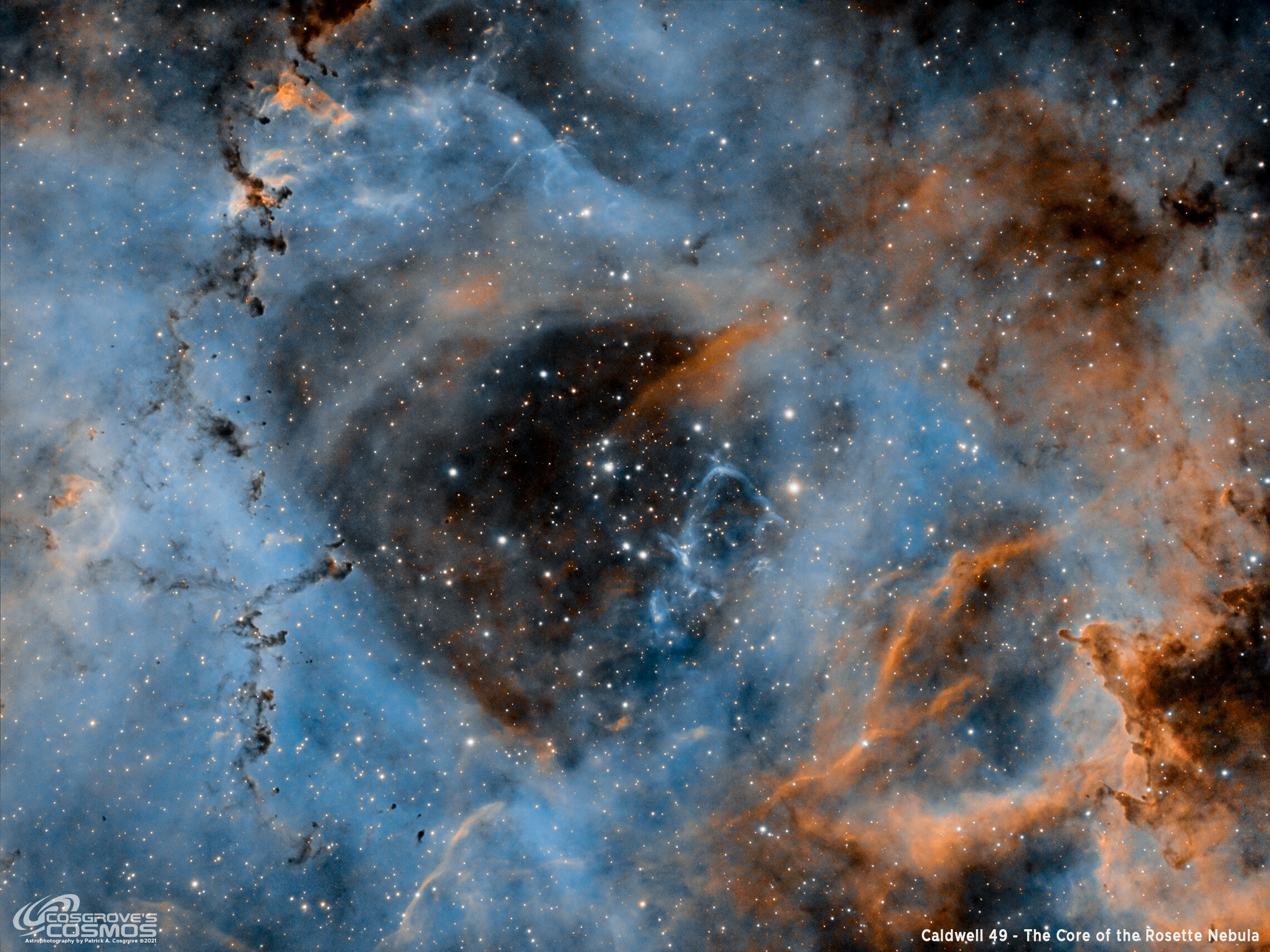C49: The Rosette Nebula in SHO
Date: March 28, 2021
Cosgrove’s Cosmos Catalog ➤#0068
Named Astrobin “Top Pick”!
Published in Astronomy Magazine Jan 2022 Edition!
I recently found out that Astronomy Magazine published this image in their Special Jan 2022 edition. The cover story was “101 Must-See Cosmic Objects,” and Object 6 was the Rosette Nebula, and my image can be seen there!
This is the first time I have been published in a major magazine. Thanks, Astronomy Mag!
Here is the link to their online version of the article: 101 Must-See Cosmic Objects: The Rosette Nebula
Published in Amateur Astrophotography Magazine!
April 9th, 2023 - In issue #111, p70-75. This image was published as part of a profile article on me!
Table of Contents Show (Click on lines to navigate)
About the Target
Also known as the "Skull Nebula" and Caldwell 49, the Rosette Nebula is a large HII region of bright gas and filaments of dark dust, located in the constellation of Monoceros. The open cluster NGC 2244 (discovered by John Flamsteed in 1690) is associated with this region - the stars of which were formed within this molecular cloud. Located 5000 light-years away, and measuring 65 light-years in diameter, the Rosette Nebula is very large with an angular diameter of about 1.3 degrees - almost 3 times the diameter of the full moon. This object is so large that there are at least five NGC listing numbers associated with it (NGC 2237, NGC 2238, NGC 2239, NGC 2244, & NGC 2246). It takes the form large gaseous "donut" and is often compared to an architectural rosette - thus its name. This area is a rich star-forming complex with over 2500 hot new stars which excite the gas and cause its glow. The stellar winds from these stars exert pressure on interstellar clouds and the compression leads to ongoing star-forming activity in the region.
The Annotated Image
The annotated image was created using Pixinsight’s ImageSolver and AnnotateImage scripts.
About the Project
This object is a very tough one for me to shoot. By the time we reach astrophotographic darkness, it is located due south near the meridian. This gives me about 1.5 hours before it moves into some trees that block my view. The fact that the moon out also did not help. Given how large the Rosette is, I really needed to shoot this with a wide field scope - but a wide field would end up hitting the trees sooner and shorted my shooting time. So I ended up using my AP130mm scope which has a focal length of 1050mm - there is no way I would end up fitting the entire object into its field of view, so I framed this to focus on the center of the "donut hole" for a more close-in study of the region. So the conditions were NOT optimal, but when you live in Rochester NY, the 18% Gray capital of the Universe, you shoot when you get some clear skies - regardless!
So over a period of 3 nights, I attempted to capture 5-minute subs with my mono camera and narrowband filters. I really did not have high hopes for this image. Once I had three nights of data, I pulled subs in and inspected them with Blink and saw something strange - many of the later subs from each evening had strange-looking stars - closer inspection showed a single line protruding from many starts. It looked like a diffraction spike, except there was only one spike! I finally realized that I was hitting the tree line sooner than I thought and the tree branches, denuded of leaves, seemed to be causing the star distortions!
So I removed the worse subs that I had and then processed them. If I had taken all of the effective subs out, I would have way too few to get a decent image, so I did leave in some that were partially affected. To my surprise, the image came out better than I expected. If you look really close, you could see what looks like some star elongations resulting including some subs that showed a little of this effect. I did some post-processing to try and correct this and I was able to reduce the effect for the most part.
So not a perfect image, but given the capture challenge, I was somewhat surprised and happy with the result I did get.
The Location in the Sky
IAU/Sky & Telescope Constellation Chart for Monoceros, showing the Rosette Nebula indicated by a yellow arrow.
Capture Details
Light Frames
Number of frames is after bad or questionable frames were culled.
12 x 300 seconds, bin 1x1 @ -15C, unity gain, Astronomiks 6nm Ha Filter
14 x 300 seconds, bin 1x1 @ -15C, unity gain, Astronomiks 6nm OIII Filter
14 x 300 seconds, bin 1x1 @ -15C, unity gain, Astronomiks 6nm SII Filter
Total of 3.3 hours
Cal Frames
45 Dark exposures
30 Ha Flat Darks
30 OIII Flat Darks
30 SII Flat Darks
30 Ha Flats
30 OIII Flats
30 SII Flats
Capture Hardware
Scope: Astrophysics 130mm Starfire F/8.35 APO refractor
Guide Scope: Televue 76mm Doublet
Camera: ZWO ASI1600mm-pro with ZWO Filter wheel with ZWO LRGB filter set,
and Astronomiks 6nm Narrowband filter set
Guide Camera: ZWO ASI290Mini
Focus Motor: Pegasus Astro Focus Cube 2
Camera Rotator: Pegasus Astro Falcon
Mount: Ioptron CEM60
Polar Alignment: Polemaster camera
Software
Capture Software: PHD2 Guider, Sequence Generator Pro controller
Image Processing: Pixinsight, Photoshop - assisted by Coffee, extensive processing indecision and second-guessing, editor regret and much swearing…..







Why a focuser for the Guidescope?
Basically I am making this change to make the platform consistent with the WO132 platform. I would like to be able to focus the guidescope remotely under computer control. I would also like to have the ability to swap camera and use the TV76 as a wide field imager (using the AP130 as the guide scope.